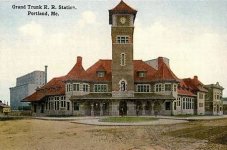The August webinar video shows a slide with public input data around the 31-minute mark. They received 17 comments in favor of Site 3; 10 in favor of Sites 1 and 2 (split evenly, 5 each); and 11 comments were neutral on the choice of site location, but in favor of relocating somewhere. You could argue public input was significantly in favor of Site 3 depending on how you break down the proportions, but taking a step back, 17 comments is not that many in absolute terms. As someone with personal experience in "making the most of" these sorts of voluntary public outreach opportunities, all you'd really need to get 17 responses are two or three people who each pester a handful of friends to send in a quick survey reply.
If you look at that same slide in the video, there are some bullet point summaries on the side. One says "maintain connections to other forms of public transportation," and another says "allow for future east/west rail service." I don't mean to relitigate this issue endlessly, but the main comparative advantage of Site 3 over Sites 1 and 2 is that it offers the easiest access to the Mountain Branch. Sites 1 and 2 are right on Congress Street's high frequency bus corridor. At risk of oversimplifying, when push came to shove, east/west rail service seems to have taken priority over transit access.
Since I haven't followed the idea of rail to Westbrook very closely, my big question has been where the push for east/west rail is coming from (i.e. is it a grassroots initiative, how much institutional buy-in is there, etc). After a quick Google search, I found the following quote in
a 2019 Press Herald article about the
conceptual study NNEPRA put together for it:
Quinn said the developer of Rock Row, Massachusetts-based Waterstone Properties Group, approached the rail authority about a year ago to discuss the possibility of a passenger rail line connecting Rock Row and Thompson’s Point. From there, the discussion evolved into the current proposal, she said, which would involve between five and six miles of track connecting the two cities’ downtown areas.
The article says the service was estimated to cost around $100 million to put in place. Everyone who was quoted seemed to acknowledge the price tag: the Chamber of Commerce called the idea "ambitious," Portland City Hall said they had to be "realistic" about the project's chances of happening, and even NNEPRA said they thought the idea of rail to Westbrook was "at least worth exploring."
Earlier this year, the Greater Portland Council of Governments released
a study calling for implementing a BRT service connecting Portland with Westbrook and Gorham. Look at PDF p.40-41 for the many reasons (cost certainly being one of them) why they decided rail was not the right transit mode. (And as for NNEPRA citing their public engagement survey to back up their study findings' legitimacy, it's worth noting the GPCOG BRT study pulled in 1,669 respondents.)
I'm sorry to ask an impertinent question, but how serious is the east/west rail proposal? If your local MPO throws a truckload of cold water on the idea, states its reasoning, and gathered
two orders of magnitude more public input than you did...and their findings came out before yours did...how do you just "tune out the haters" and let east/west rail play such a central role in your station relocation decision?
The world won't end if the relocated station gets built on Site 3, but Portland shouldn't have to settle for this, or pretend that this outcome was reached purely through sound reasoning.


